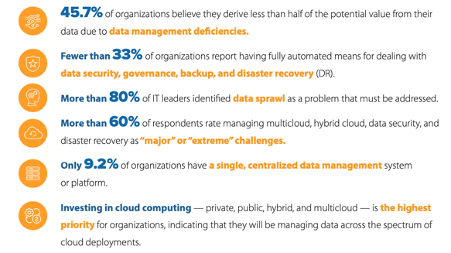London, UK | 020 3997 7979
Hybrid Cloud Infrastructure
Don't let data sprawl sabotage your business goals
07 August 2020 | Nik Grove
Valuable data is commonly spread across multiple physical locations and different repository types. It is stored in core datacentres, public cloud locations including SaaS applications, and at the edge, including remote locations, endpoint devices and specialised IoT devices. It may be stored as structured data, widely varying unstructured data, newer NoSQL data types and emerging container microservices.
New research by IDC, commissioned by Rubrik, revealed that businesses manage an average of 25 discrete data solos separated by geography or technology.
This has created a problem called ‘data sprawl’ or ‘data fragmentation’.
The problem with Data Sprawl
While Hybrid Cloud deployments are not a new solution in the industry, the associated data sprawl is the main poor data management practice that comes with the model, and is increasingly being looked at with concern by IT Management and Data Management Professionals.
Having signed up for IaaS, PaaS and SaaS solutions with a variety of vendors, each selected as the best option for the business, many are now starting to worry that individual data protection solutions for each element are exposing the business to unacceptable levels of risk and consuming a large amount of management time.
Key findings from the IDC report include:

The IDC Data Forward Enterprise report confirms everything we suspect
There is a significant business benefit to be had from using hybrid and multi-cloud services. Leading data forward enterprises are reaching 76% annual growth according to the IDC report; achieved by analysing, combining and leading their business using more than 75% of their available data set from these multi-cloud architectures.
The report also confirms that once you’ve transformed into this data led enterprise, you can’t afford to be without it. With your data split across an average of 25 data silos it should be protected with an enterprise solution and managed centrally.
With less than 10% of organisations currently having a centralised data management system it’s clear that there’s a lot of time being consumed; effort being wasted and business risk out there from using an increasing number of point solutions.
Organisations with more mature enterprise data management practices are gaining from tangible results, including 90% reduction in compliance fines and a 64% increase in time spent by IT staff on new initiatives, rather than just 'keeping the lights on'.
Get the big picture about the power of better data management
The full stats are in the report but the headline facts from the study are that there are material improvements on IT staff productivity, reductions in downtime and regulatory related fines and acceleration of business initiatives from being able to not only utilise these services but know you can rely on them to be available as well.
Since its inception, Rubrik’s purpose has been to build an enterprise grade multi-cloud data protection platform. With links into all of the primary public cloud IaaS facilities and with SaaS solutions such as Office365 already available in the market, the platform is perfectly placed to modernise your backup infrastructure as you continue to transition into a Data Forward Enterprise.



